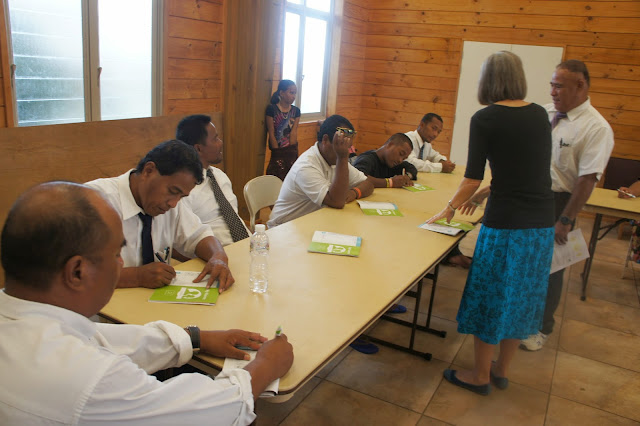We returned last night from a 10 day visit to Chuuk, Pohnpei and Kosrae where we trained leadership in Family History and introduced the members to the new "My Family: Stories That Bring Us Together" booklet. It was both a humbling and challenging experience.
Our first stop was Chuuk, a lagoon state and largest of the Federated States of Micronesia where district and branch leaders gathered at the Mwan Chapel on the main island of Weno. Relief Society sisters helped us teach the members how to use the booklet.
The young man at the end of the table is the President of the Tonoas Branch who is planning to attend the Manila Temple in June, along with 15 others from the branch, to be sealed to his wife and two children.
Next stop was Pohnpei island, the largest, highest, most populous and most developed single island in the FSM and seat of its government. A stake was created here in March and a temple trip is planned for June. Several Family History Consultants have been called and are helping members here.
This is Bradley Spirin, an new member and enthusiastic consultant in the Pangasang Ward, Pohnpei.
Saturday morning we visited the mysterious ruins of Nan Madol. We had to wade through the tidal pools to reach it- thus Grant's style-setting apparel.
This ruined city adjacent to the eastern shore of the island of Pohnpei was the capital of the Saudeleur dynasty until about 1628.
Easter morning we met with the Saints of the Kitti Branch in their rented chapel.
Brother Iopplite Route served as our interpreter as we taught the importance of seeking out and providing ordinances for our dead. He delivered our message with a strong spirit. Here he is with his wife Patsipa and family. They plan to attend the Manila temple this summer to be sealed.
President Eugene Conrad of the Kitti Branch is doing all he can to encourage and support temple work and attendance among the members of the branch. His wife is the family history consultant as well as the Seminary teacher.
Mayleen Lipai is a 14 year old Young Woman in the Pangasang Ward, Pangasang Pohnpei Stake who enjoys learning about her family and filling out the "My Family" booklet.
Next stop was the tiny island is Kosrae, easternmost of the Caroline Island with a population of just over 6,500, where Tulpe Nena serves as family history consultant in the Lelu Branch and Wanda June Linus in the Utwe Branch. We met with members there and introduced the "My Family" booklet.
This beautiful family is planning a trip to the Manila Temple this summer to be sealed.
Members work on the "My Family" booklet with the help of Elder Despain who translated for us.
As usual, the Relief Society sisters of Kosrae provided a wonderful meal for all of us after the presentation which included traditional foods such as breadfruit, coconut, banana and taro
as well as famous Kosrae tangerines introduced to the island by the Japanese in the last century.
Tuesday afternoon we were bumped from our flight back to Guam and spent an extra four days in Kosrae. We took the opportunity to snorkel, hike to the Menke ruins through pristine rain forest, visit the Lelu ruins, and kayak in the mangrove channels.
The rain forest was stunning and full of interesting colors and textures like this Eucalyptus trunk,
bamboo
wild ginger
and fern.
The most amazing thing about these islands are the members who, despite economic and technological challenges, strive to make and keep their covenants, love their families and love the Lord.


































